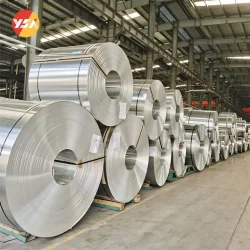



Coffee capsule aluminum foil substrate
Aluminum foils of AA 8011 and AA 8021 are common choices suitable for coffee capsule aluminum lid and shell fabrication.
Depending on the size of the coffee capsule and the strength required, the appropriate thickness of aluminum foil is selected. A common range is usually between 0.03 mm and 0.1 mm.
Coffee capsule aluminum have some differences in fabrication and function. Coffee capsule lids usually use a single layer of aluminum foil as the substrate, which provides sufficient flexibility, while coffee capsule shells usually use a double layer of aluminum foil, one of which may be coated or anodized to provide better protection and corrosion resistance.
So the lid aluminum foil substrate is usually thinner than the shell. The lid foil substrate is usually between 0.03 mm and 0.05 mm thick, while the shell foil substrate is usually between 0.05 mm and 0.1 mm thick. The shell requires higher strength to maintain structural stability and sealing of the capsule.
Both the cap and the shell of a coffee capsule need to have good closure properties to prevent leakage of the coffee during processing, transportation and storage. Closure between the lid and shell is usually achieved by heat-sealing the film, welding or other sealing techniques.
The lids of the coffee capsules may have brand logos, colorful patterns, or other decorative elements to increase the attractiveness of the product. Coffee capsule shells, on the other hand, are more structurally and functionally oriented.
An anodized and/or coated finish can provide additional corrosion resistance, ensuring that the aluminum foil will not corrode when in contact with coffee and other substances.
Anodizing and coating treatments are common surface treatments that enhance the appearance and corrosion resistance of aluminum foil, which is very important for coffee capsule housings.
Anodizing is achieved by forming an aluminum oxide film on the surface of the aluminum foil. This aluminum oxide film has good corrosion resistance and hardness, and provides additional protection against reactions between the aluminum and coffee or other substances.
Coating treatments are usually applied after anodizing and can provide additional protection and decorative effects. The coating can be organic or inorganic, and the exact choice can be determined by the customer’s needs and application.

Coffee capsule production
1. Different materials and sizes of the coffee capsule aluminum can be selected as needed. The ground coffee is made from a specific selection of coffee beans, which are ground and blended to obtain the desired flavor and consistency.
2. Capsule shells can be fabricated by either injection molding or deep stamping processes. In the injection molding process, molten plastic is injected into a mold, cooled and cured to form the capsule shell. In the deep stamping process, the cup shell is formed by stamping coffee capsule aluminum into a specific shape.
3. Pre-ground coffee powder is filled into the capsule shell. The amount of coffee powder is usually determined based on the desired strength and flavor. After filling, it is ensured that the coffee powder is evenly distributed and not overly compacted.
4. After filling with ground coffee, the capsule needs to be sealed. This can be done by sealing the top of the capsule with heat sealing film or aluminum foil. The heat sealing film or aluminum foil is tightly bonded to the capsule shell through a heat sealing process, ensuring that the capsule remains sealed during storage and transportation. Some coffee capsule manufacturers fill the inside of the capsule with a gas, usually an inert gas such as nitrogen.
Gas filling plays an important role in the coffee capsule manufacturing process. It effectively removes oxygen from the capsule, reducing oxidization and maintaining the freshness and taste of the coffee. Gas filling can also help keep the pressure inside the capsule stable to prevent capsule deformation or leakage.
5. After completing the capsule production with coffee capsule aluminum, it will be packaged and labeled. The common way of packaging is to put the capsules into bags, cartons or aluminum foil bags and then seal them. Information such as the type of coffee, strength, place of origin and expiration date will be labeled on the package.
FAQ: How Coffee Capsules Work?
- Sealed container: Coffee capsules are designed as sealed containers that hold a specific amount of ground coffee. The capsule is airtight, protecting the coffee from exposure to air, light, and moisture, which helps to preserve its freshness and flavor.
- Compatibility: Coffee capsules are designed to be compatible with specific coffee machines or systems. The shape, size, and piercing mechanism of the machine are designed to fit and puncture the capsule, allowing water to flow through it during the brewing process.
- Brewing process: When a coffee capsule is inserted into a compatible coffee machine, the machine pierces the capsule to create openings for water to enter. The machine then injects hot water under pressure into the capsule. The water flows through the ground coffee, extracting its flavor and aroma.
- Filtration: As the water passes through the coffee grounds inside the capsule, it also passes through a filter or mesh within the capsule. This filter helps to separate the brewed coffee from the spent grounds, ensuring that only the liquid coffee is extracted.
- Dispensing: Once the brewing process is complete, the machine dispenses the brewed coffee into a cup or mug. Some coffee machines also offer options for adjusting the strength or size of the coffee serving.
Coffee capsules offer several advantages:
Convenience: Coffee capsules provide a quick and convenient way to brew a single serving of coffee without the need for grinding beans or measuring coffee grounds.
Consistency: Each coffee capsule contains a pre-determined amount of coffee, ensuring consistency in strength and flavor with each brew.
Freshness: Coffee capsules are individually sealed, protecting the coffee from exposure to air, light, and moisture until it is brewed, which helps to maintain its freshness.
Minimal cleanup: After brewing, the used coffee capsule can be easily discarded, reducing the need for cleaning traditional coffee brewing equipment.

